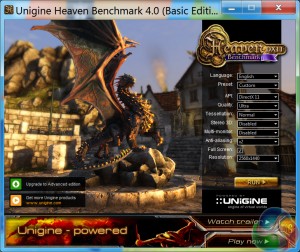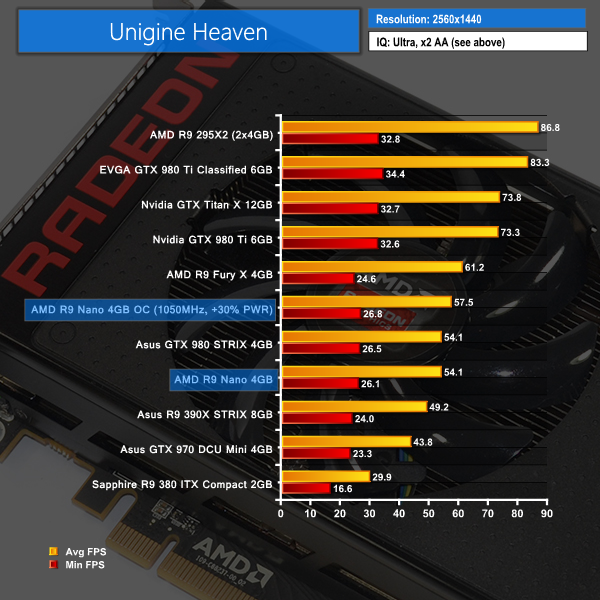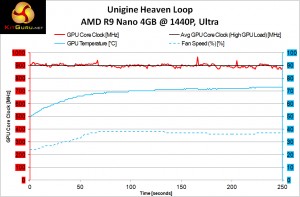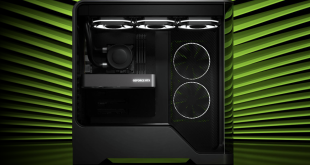Unigine provides an interesting way to test hardware. It can be easily adapted to various projects due to its elaborated software design and flexible toolset. A lot of their customers claim that they have never seen such extremely-effective code, which is so easy to understand.
Heaven Benchmark is a DirectX 11 GPU benchmark based on advanced Unigine engine from Unigine Corp. It reveals the enchanting magic of floating islands with a tiny village hidden in the cloudy skies. Interactive mode provides emerging experience of exploring the intricate world of steampunk. Efficient and well-architected framework makes Unigine highly scalable:
- Multiple API (DirectX 9 / DirectX 10 / DirectX 11 / OpenGL) render
- Cross-platform: MS Windows (XP, Vista, Windows 7) / Linux
- Full support of 32bit and 64bit systems
- Multicore CPU support
- Little / big endian support (ready for game consoles)
- Powerful C++ API
- Comprehensive performance profiling system
- Flexible XML-based data structures
We set Quality to ‘Ultra', Tessellation to ‘Normal', Anti Aliasing to 2x, and the resolution to 2560×1440.
With Unigine Heaven running at a 1440P resolution, not 4K, the stock-clocked R9 Nano is able to match the performance of Asus' factory-overclocked GTX 980 STRIX.
Opening the power taps and increasing the target clock speed sees the R9 Nano jump above Asus' GTX 980 STRIX and sit directly between performance of the factory-overclocked Nvidia solution and AMD's flagship R9 Fury X.
The AMD R9 Nano's average core clock speed for the roughly 250 second run of Unigine Heaven was around 900MHz when using the default card settings. In this usage case, power delivery limits seem to be the primary driver for PowerTune core clock management, as the GPU temperature remained below 75°C.
 KitGuru KitGuru.net – Tech News | Hardware News | Hardware Reviews | IOS | Mobile | Gaming | Graphics Cards
KitGuru KitGuru.net – Tech News | Hardware News | Hardware Reviews | IOS | Mobile | Gaming | Graphics Cards






Price!! AMD… I know it’s unique but you had a good opportunity to fight NVIDIA but you priced yourself too high (again).
And with their yield issues it will be priced even higher at retailers lol.
Who are you kidding?
I can’t see how they can charge the same as a Fury X and the Fury X has the added cost of watercooling.
Don’t matter on price, Gaming enthusiast’s will buy it just because of the size and performance it give’s, If people are willing to spend like 1500 for a titan X, I’m sure people will pay 1/3 of the price for the nano.
Can you cram Fury x into SFF case?
^ This, it delivers very well for the size/form factor in spades. But if anyone has the space/non ITX case to house longer cards the Nano isn’t for them, people just need to realize this and move on.
yes. Read a review somewhere (Hexus?) where they mentioned you could cram a Fury X into some mITX cases 🙂
Most mITX cases are long, to incorporate a full sized GFX card, you can for example get a Strix 980 into a Fractal Node 304. It’s only when you get down to stuff like the Coolermaster Elite 110 that an mITX card becomes necessary.
For £515 you can buy a 980Ti, unless you really needed a smaller card why would you purchase this ?
Indeed. Most of the people complaining about the niche this card lives in wouldn’t be buying one anyway, they’re just more interested in complaining about it.
Most of the complaining is from nvidia fanboys, trolls or paid shills. There is no way a sane consumer can be totally blind to the value proposition this card gives in ultra SFF compared to useless value the titan X gives when it is so overpriced for any form factor.
Of course there are some legitimate voices of dissatisfaction among those who really wanted to buy this card thinking it will be a more cut down version of Fiji chip and could be had for like 400-450 USD, those people have legit reasons to be slightly miffed but given the performance this thing shows they will quickly realize this card isn’t for them, the $549 R9 Fury is.
I would buy it with no hessitation, and I’m a full tower user.